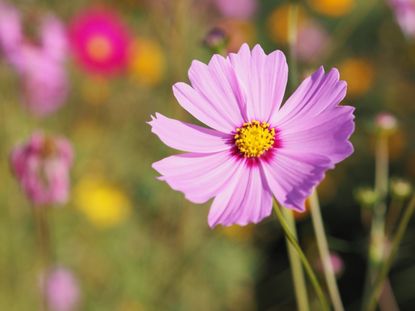Cosmos Flower Care - Tips For Growing Cosmos


Cosmos plants (Cosmos bipinnatus) are an essential for many summer gardens, reaching varying heights in many colors, adding frilly texture to the flower bed. Growing cosmos is simple and cosmos flower care is easy as well as rewarding when single or double blooms appear on stems reaching 1 to 4 feet (0.5-1 m.).
Cosmos plants may be featured at the back of a descending garden or in the middle of an island garden. Taller varieties may need staking if not planted in an area protected from the wind. Planting cosmos flowers results in many uses of the specimen, such as cut flowers for the indoor display and backgrounds for other plants. Cosmos can even be used as screens to hide unsightly elements in the landscape.
How to Grow Cosmos Flowers
When planting cosmos flowers, locate them in soil that has not been heavily amended. Hot dry conditions, along with poor to average soil, are optimum conditions for growing cosmos. Cosmos plants are usually grown from seed. Scatter seeds of the cosmos onto a bare area in the location where you wish to have growing cosmos.
Once planted, this annual flower self-seeds and will provide more cosmos flowers in the area for years to come. Daisy-like flowers of the cosmos plant appear atop tall stems with lacy foliage. Cosmos flower care can include the deadheading of flowers as they appear. This practice forces growth lower on the flower stem and results in a stronger plant with more flowers. Cosmos flower care can include cutting flowers for indoor use, achieving the same effect on the growing cosmos plant.
Varieties of Cosmos
More than 20 varieties of cosmos plants exist, both annual and perennial varieties. Two annual varieties of cosmos plants are primarily grown in the U.S. Cosmos bipinnatus, called the Mexican aster and Cosmos sulphureus, or yellow cosmos. Yellow cosmos is somewhat shorter and more compact than the commonly used Mexican aster.
Another interesting variety is Cosmos atrosanguineus, the chocolate cosmos. If there are no cosmos to self-seed in your flower bed, get some started this year. Direct sow this frilly flower into a bare area of the bed that will benefit from tall, colorful, easy care blooms.
Gardening tips, videos, info and more delivered right to your inbox!
Sign up for the Gardening Know How newsletter today and receive a free download of our most popular eBook "How to Grow Delicious Tomatoes."

Becca Badgett was a regular contributor to Gardening Know How for ten years. Co-author of the book How to Grow an EMERGENCY Garden, Becca specializes in succulent and cactus gardening.
-
 "My Worst Mistake" – Gardeners Share 10 Hard-Learned Lessons
"My Worst Mistake" – Gardeners Share 10 Hard-Learned LessonsGardeners never stop learning, and sometimes our mistakes are the best teachers. But why not save time and heartache by learning from other gardeners' failures?
By Melanie Griffiths
-
 Crops for Urban Growing: 8 Edible Plants For Urban Gardens
Crops for Urban Growing: 8 Edible Plants For Urban GardensUrban edible gardening lets your yard do double duty of beauty and practicality. Have fun combining edible plants with ornamentals.
By Teo Spengler
-
 Cutting Back Cosmos For More Blooms
Cutting Back Cosmos For More BloomsCutting cosmos will give you new flowers for the entire growing season as well as blooms for floral arrangements. Click to learn when and how.
By Mary Ellen Ellis
-
 Sulphur Cosmos Information – How To Grow A Mexican Aster Flower
Sulphur Cosmos Information – How To Grow A Mexican Aster FlowerBy Mary Ellen Ellis
-
 Cosmos Plant Varieties: Learn About Types Of Cosmos Plants
Cosmos Plant Varieties: Learn About Types Of Cosmos PlantsWhen it comes to considering the many types of cosmos plants on the market, gardeners are faced with a wealth of riches. Learn about a few of the best cosmos plant varieties and cosmos flower types for the garden in this article.
By Mary H. Dyer
-
 Cosmos Flower Diseases – Reasons Cosmos Flowers Are Dying
Cosmos Flower Diseases – Reasons Cosmos Flowers Are DyingCosmos plant diseases range from fungal to bacterial and into insect vectored viruses. Controlling insects, providing proper irrigation and planting healthy plants can minimize these problems. Click here to learn more in this article.
By Bonnie L. Grant
-
 Companion Plants For Cosmos – Learn About Cosmos Companion Plants
Companion Plants For Cosmos – Learn About Cosmos Companion PlantsWhat grows well with cosmos, and why do cosmos need companions? Companion planting serves a number of valuable purposes in the garden. Click this article to find out what plants grow well with cosmos in the garden.
By Mary H. Dyer
-
 Common Insects On Cosmos: Treating Pests On Cosmos Plants
Common Insects On Cosmos: Treating Pests On Cosmos PlantsCosmos plant pests are rare and generally don't cause significant damage to the health of the plant. What pests do cosmos get? Learn about treating pests on cosmos plants in this article and keep your flowers looking beautiful.
By Bonnie L. Grant
-
 Caring For Chocolate Cosmos Plants: Growing Chocolate Cosmos Flowers
Caring For Chocolate Cosmos Plants: Growing Chocolate Cosmos FlowersChocolate isn't just for the kitchen, it's also for the garden, especially a chocolate one. Growing chocolate cosmos flowers will delight any chocolate lover. This article had information on its care in the garden. Click here to learn more.
By Gardening Know How
-
 Cosmos Not Flowering: Why Are My Cosmos Not Blooming
Cosmos Not Flowering: Why Are My Cosmos Not BloomingCosmos is a showy annual plant commonly grown in gardens. But what happens when there are no blooms on cosmos? Read this article to learn more about why cosmos will not flower.
By Susan Patterson